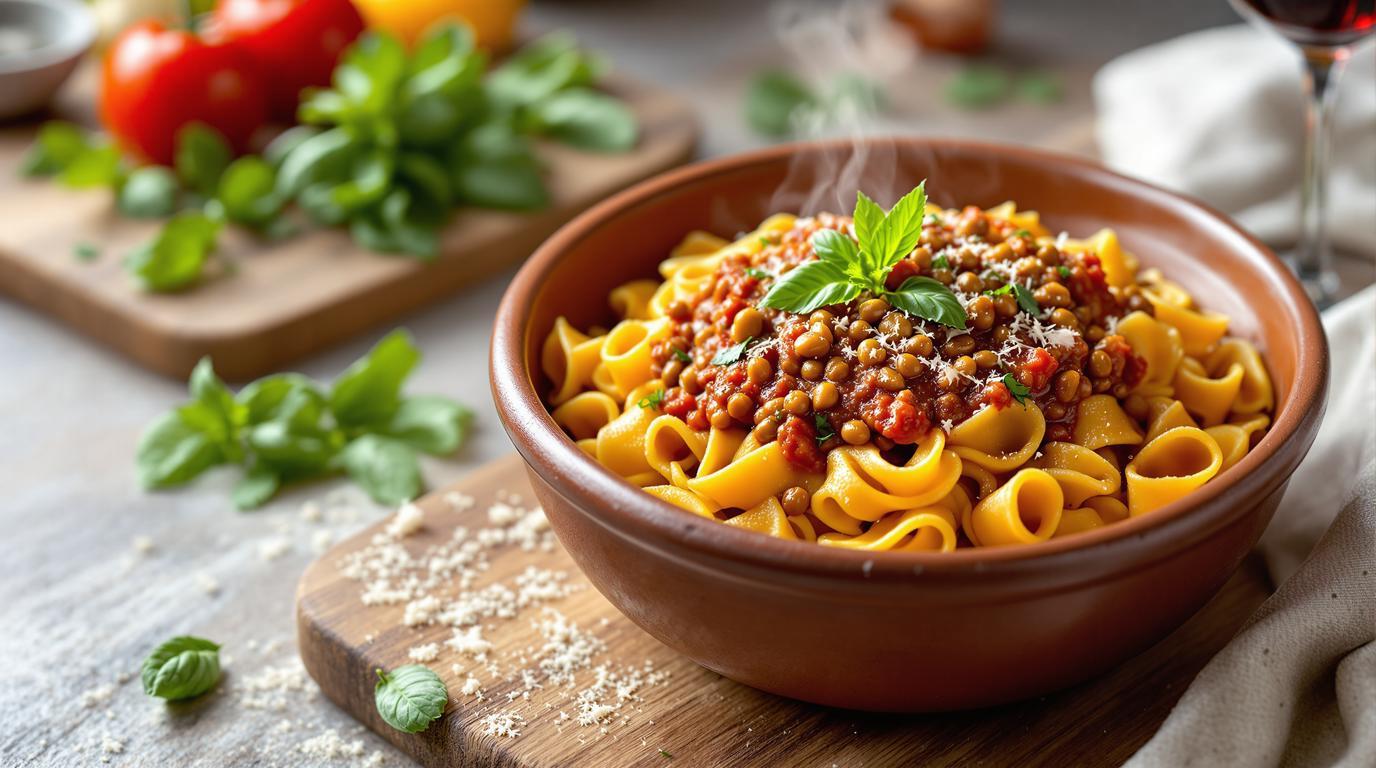There’s a special kind of magic that happens when a pot of Bolognese simmers on the stove, filling the kitchen with an aroma that takes you straight to the rolling hills of Emilia-Romagna. My grandmother—who wasn’t Italian but had a deep appreciation for their cooking traditions—taught me that patience and layering of flavors is what transforms simple ingredients into something extraordinary. When I developed this lentil variation of the classic Bolognese, I wanted to honor those principles while creating something accessible for modern, plant-forward kitchens. The result? A sauce with all the depth and satisfaction of the traditional version, but centered around protein-rich lentils instead of meat.
The Heart of Lentil Bolognese 📖
Traditional Bolognese sauce, or ragù alla Bolognese, has been simmering on Italian stovetops for centuries. While the authentic version relies on slow-cooked meat, my lentil adaptation preserves the fundamental technique of building flavors gradually. The key is respecting the process—taking time with each layer of flavor, from browning aromatics to developing the umami-rich tomato paste before introducing the lentils.
I first made this recipe after returning from a cooking sabbatical in Northern Italy, where I learned that authentic Bolognese isn’t actually heavy on tomatoes, but rather uses them as a subtle background note. Similarly, this lentil version balances tomatoes with a carefully crafted base of vegetables, herbs, and a splash of wine for depth.
The Foundation: Mirepoix Magic 🧾
Begin with these essential components:
- 2 tablespoons extra virgin olive oil
- 1 large onion, finely diced (about 2 cups)
- 1½ cups each finely diced carrots and celery (brunoise cut if you’re feeling fancy)
- 4-6 garlic cloves, minced
- 1 cup small French green or black caviar lentils (never use red—they disintegrate)
- 3 tablespoons tomato paste (the concentrated kind in a tube offers superior flavor)
- ½ cup good red wine (one you’d drink—I prefer Sangiovese)
- 14 oz (400g) crushed tomatoes
- 3½ cups (830ml) low-sodium vegetable broth
- ¾ cup (85g) toasted walnuts, finely ground
- 2 tablespoons aged balsamic vinegar
- 1 teaspoon dried Italian herbs (or fresh oregano and thyme)
- Salt, pepper, and red pepper flakes to taste
The Art of Building Flavors 📝
1. Begin by heating olive oil in a heavy-bottomed Dutch oven over medium heat. Add your onions first, cooking until they turn translucent and begin to sweeten, about 5 minutes.
2. Introduce the carrots and celery, cooking until they soften but don’t brown, another 5-7 minutes. This vegetable base, known as soffritto in Italian cooking, is the foundation upon which all great Bolognese is built.
3. When the vegetables are soft, add the garlic and herbs, cooking just until fragrant, about 60 seconds. Be vigilant here—garlic burns quickly and becomes bitter.
Chef’s Note: The secret to depth in any plant-based sauce is taking the time to properly brown the tomato paste. This step caramelizes the natural sugars and develops complex flavors that mimic the richness typically achieved through meat.
4. Add the tomato paste and cook, stirring constantly, for 2-3 minutes until it darkens slightly and becomes fragrant. This transforms the sharp, acidic paste into something deep and complex.
5. Deglaze with red wine, scraping up any browned bits from the bottom of the pot—these contain concentrated flavor. Allow the wine to reduce by half. (If avoiding alcohol, substitute with 2 tablespoons of balsamic vinegar and ¼ cup broth.)
6. Add the lentils, crushed tomatoes, ground walnuts (which provide body and a subtle meatiness), and vegetable broth. Bring to a gentle boil, then reduce to a simmer.
7. Cover and cook for 25-30 minutes for black lentils or up to 40 minutes for French green varieties, stirring occasionally to prevent sticking. You want the lentils tender but still maintaining their shape.
8. Remove the lid and simmer for an additional 10-15 minutes to thicken the sauce. Finish with balsamic vinegar and adjust the seasoning with salt and pepper.
The Final Touch: Presentation 🍽️
Serve this hearty sauce over al dente tagliatelle or rigatoni, which catch and hold the sauce beautifully. For the authentic Italian experience, toss your pasta directly in the sauce with a splash of pasta water before serving, allowing the starch to help bind everything together.
A light grating of Parmesan (or plant-based alternative) and fresh basil leaves brighten the dish. For a complete meal, serve alongside a crisp green salad or rustic bread for mopping up the remaining sauce.
This recipe creates a beautiful bridge between tradition and modern cooking—much like the Polish cabbage rolls or Moroccan pastilla that have evolved over generations. While purists might insist that Bolognese requires meat, I’ve found that this lentil version satisfies even the most traditional palates while offering a plant-forward alternative that doesn’t compromise on flavor or texture.
The true spirit of Italian cooking isn’t about rigid rules but about creating food with love and attention to detail. My grandmother would have approved of this adaptation—after all, as she often reminded me, “Cooking is about feeding bodies, but great cooking nourishes the soul.” Whether you’re looking to incorporate more plant-based meals or simply seeking a delicious, hearty pasta sauce, this lentil Bolognese delivers warmth and satisfaction to your table in true Italian spirit.
